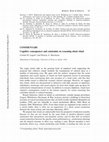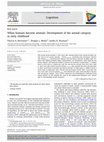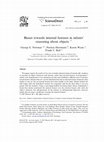Papers by patricia herrmann
In-Group Affiliation Measure
PsycTESTS Dataset, 2016
Ritual increases children’s affiliation with in-group members
Evolution and Human Behavior, 2016
ABSTRACT This study examined the impact of ritual participation on children’s in-group affiliatio... more ABSTRACT This study examined the impact of ritual participation on children’s in-group affiliation (N = 71, 4-11-year-old children). A novel social group paradigm was used in an afterschool program to test the influence of a ritual versus a control task on a measure of affiliation with in-group versus out-group members. The data support the hypothesis that the experience of participating in a ritual increases in-group affiliation to a greater degree than group activity alone. The results provide insight into the early-developing preference for in-group members and are consistent with the proposal that rituals facilitate in-group cohesion. We propose that humans are psychologically prepared to engage in ritual as a means of in-group affiliation.

Religion, Brain & Behavior, 2013
The target article adds to the growing body of empirical work supporting the proposal that collec... more The target article adds to the growing body of empirical work supporting the proposal that collective rituals facilitate the transmission of cultural ideas in a number of interesting ways. We agree with the authors' proposal that the social stipulation and causal opacity of rituals are both important factors in preventing individuals from constructing their own accounts of a ritual event, and that they both enable rituals to effectively transmit cultural messages. However, we suggest that rituals, which are characterized as behaviors with high amounts of repetition, redundancy, stereotypy, and causal opacity, do more than simply open up space for authoritative interpretations of events. In addition to resource depletion, rituals have cognitive consequences rooted in the human capacity for causal reasoning that contribute directly to cultural learning. Rituals behaviors, which we define as conventional, causally opaque procedures (Legare, Whitehouse, Herrmann, & Wen, in press), present a challenge to theoretical accounts of causal reasoning because they are both socially stipulated (Humphrey & Laidlaw, 1994) and not reducible to causal mechanisms (Bloch, 2004; Boyer & Liénard, 2006; Whitehouse, 2001). Even when rituals are explained in the context of a certain belief, there is often not an expectation of a direct causal connection between the ritual actions and outcomes (Sørensen, 2007). We propose that rituals are unknowable from the perspective of physical causality because (1) they are not bound by the same kinds of intuitive physicalÁcausal constraints that characterize non-ritualistic actions, and (2) they lack an intuitive causal connection between the specific action performed (e.g., synchronous dancing) and the desired outcome or effect (e.g., making it rain). Rituals intended to have particular effects (e.g., rituals promoting crop fertility or healing the sick) are not

Cognition, 2012
The current study examines 3-and 5-year-olds' representation of the concept we label 'animal' and... more The current study examines 3-and 5-year-olds' representation of the concept we label 'animal' and its two nested concepts-animal contrastive (including only non-human animals) and animal inclusive (including both humans and non-human animals). Building upon evidence that naming promotes object categorization, we introduced a novel noun for two distinct objects, and analyzed children's patterns of extension. In Experiment 1, children heard a novel noun in conjunction with two non-human animals (dog, bird). Here, both 3-and 5-year-olds readily accessed animal contrastive and extended the noun systematically to other (previously un-named) non-human animals. In Experiment 2, children heard a novel noun in conjunction with a human and non-human animal. Here, 5-year-olds (but not 3-year-olds) accessed animal inclusive and extended the noun systematically to humans and non-human animals. These results underscore the developmental challenge facing young children as they identify the scope of the fundamental biological term 'animal' and its corresponding, nested concept(s).
towards internal features in infants’ infants were familiarized to two animated cats that each ex... more towards internal features in infants’ infants were familiarized to two animated cats that each exhibited a different style of self-gen-
Imitative flexibility and the development of cultural learning
Cognition, 2015
Two studies test the hypothesis that imitative fidelity is influenced by cues to interpret behavi... more Two studies test the hypothesis that imitative fidelity is influenced by cues to interpret behavior as instrumental versus conventional. Study 1 (N=57, 4-5-yr-olds) manipulated non-verbal cues (start- and end-states of action sequences) and Study 2 (N=211, 4-6-yr-olds) manipulated verbal cues to examine the effects of information about instrumental versus conventional goals on imitative fidelity. Imitative fidelity was highest (Studies 1 and 2), innovation was lowest (Study 1), and difference detection was more accurate (Study 2) when cued with information about conventional rather than instrumental behavior. The results provide novel insight into the kinds of information children use to adjudicate between instrumental and conventional behavior.
Proceedings of the National Academy of Sciences, 2010

Essentialist Reasoning and Knowledge Effects on Biological Reasoning in Young Children
Merrill-Palmer Quarterly, 2013
ABSTRACT Biological kinds undergo a variety of changes during their life span, and these changes ... more ABSTRACT Biological kinds undergo a variety of changes during their life span, and these changes vary in degree by organism. Understanding that an organism, such as a caterpillar, maintains category identity over its life span despite dramatic changes is a key concept in biological reasoning. At present, we know little about the developmental trajectory of children's understanding of dramatic life-cycle changes and how this might relate to their understanding of evolution. We suggest that this understanding is a key precursor to later understanding of evolutionary change. Two studies examined the impact of age and knowledge on children's biological reasoning about living kinds that undergo a range of natural life-span changes—from subtle to dramatic. The participants, who were 3, 4, and 7 years old, were shown paired pictures of juvenile and adult animals and asked to endorse biological or nonbiological causal mechanisms to account for life-span change. Additionally, reasoning of 3- and 4-year-old participants was compared before and after exposure to caterpillars transforming into butterflies. The results are framed in terms of a developmental trajectory in essentialist reasoning, a cognitive bias that has been associated with difficulties in understanding and accepting evolution.

Humans (really) are animals: picture-book reading influences 5-year-old urban children’s construal of the relation between humans and non-human animals
Frontiers in Psychology, 2014
What is the relation between humans and non-human animals? From a biological perspective, we view... more What is the relation between humans and non-human animals? From a biological perspective, we view humans as one species among many, but in the fables and films we create for children, we often offer an anthropocentric perspective, imbuing non-human animals with human-like characteristics. What are the consequences of these distinctly different perspectives on children's reasoning about the natural world? Some have argued that children universally begin with an anthropocentric perspective and that acquiring a biological perspective requires a basic conceptual change (cf. Carey, 1985). But recent work reveals that this anthropocentric perspective, evidenced in urban 5-year-olds, is not evident in 3-year-olds (Herrmann etal., 2010). This indicates that the anthropocentric perspective is not an obligatory first step in children's reasoning about biological phenomena. In the current paper, we introduced a priming manipulation to assess whether 5-year-olds' reasoning about a novel biological property is influenced by the perspectives they encounter in children's books. Just before participating in a reasoning task, each child read a book about bears with an experimenter. What varied was whether bears were depicted from an anthropomorphic (Berenstain Bears) or biological perspective (Animal Encyclopedia). The priming had a dramatic effect. Children reading the Berenstain Bears showed the standard anthropocentric reasoning pattern, but those reading the Animal Encyclopedia adopted a biological pattern. This offers evidence that urban 5-year-olds can adopt either a biological or a human-centered stance, depending upon the context. Thus, children's books and other media are double-edged swords. Media may (inadvertently) support human-centered reasoning in young children, but may also be instrumental in redirecting children's attention to a biological model.

Stick to the script: The effect of witnessing multiple actors on children’s imitation
Cognition, 2013
What kinds of cues increase imitative fidelity in early childhood? The effects of multiple models... more What kinds of cues increase imitative fidelity in early childhood? The effects of multiple models and verbal framing were examined in preschool children (N = 259, 3-6-year-olds). Each participant was presented with one of eight possible combinations of type of modeling and verbal frame. The type of modeling involved: (i) a single model offering two demonstrations, (ii) two successive models each offering a single demonstration, (iii) two synchronous models each offering two demonstrations, or (iv) two synchronous models each offering a single demonstration. The verbal frame preceding the demonstrations emphasized either the instrumental outcome of the actions or their conventionality. Imitative fidelity was highest for the synchronous models (types iii and iv) and lowest for the single model (type i). Imitative fidelity was also higher for the convention-oriented than the outcome-oriented frame and higher for older than younger children. Children also provided more conventional explanations for their actions after viewing the synchronous models and after the convention-oriented framing. The results indicate that children's imitative fidelity depends on the number of actors and the way the actions are framed.

Cognition, 2008
This paper reports the results of two sets of studies demonstrating 14-month-olds' tendency to as... more This paper reports the results of two sets of studies demonstrating 14-month-olds' tendency to associate an object's behavior with internal, rather than external features. In Experiment 1 infants were familiarized to two animated cats that each exhibited a different style of self-generated motion. Infants then saw a novel individual that had an internal feature (stomach color) similar to one cat, but an external feature (hat color) similar to the other. Infants looked reliably longer when the individual's motion was congruent with the hat than when it was congruent with the stomach. Using a converging method involving object choice, Experiment 2 found that infants prioritized the internal feature over the external feature only when the object's behavior was self-generated. In the absence of self-generated behaviors, however, infants did not show a preference towards the internal feature.
Biases Towards Internal Features in Infants
Cognition, May 1, 2008
This paper reports the results of two sets of studies demonstrating 14-month-olds' tendency ... more This paper reports the results of two sets of studies demonstrating 14-month-olds' tendency to associate an object's behavior with internal, rather than external features. In Experiment 1 infants were familiarized to two animated cats that each exhibited a different style of ...











Uploads
Papers by patricia herrmann